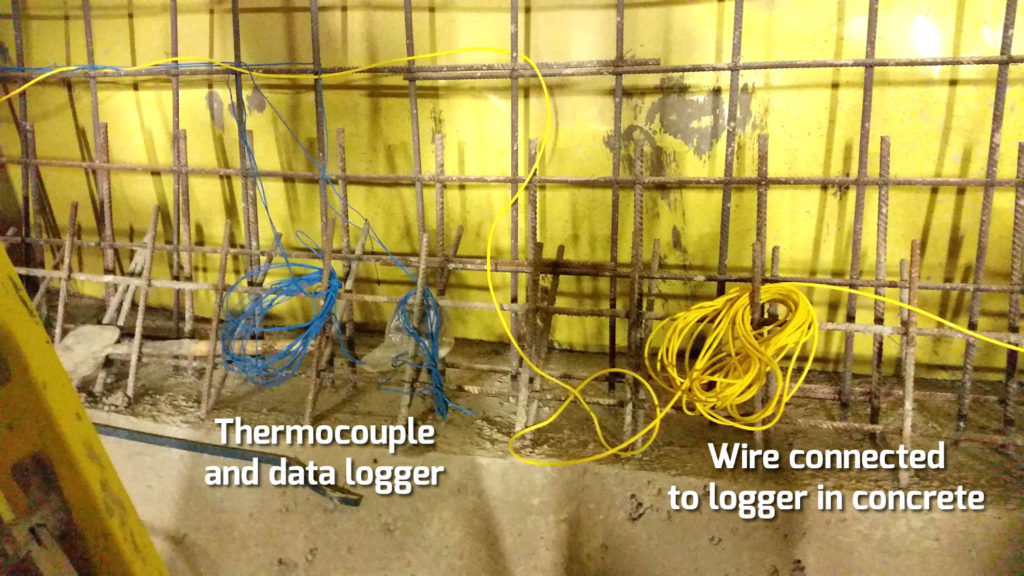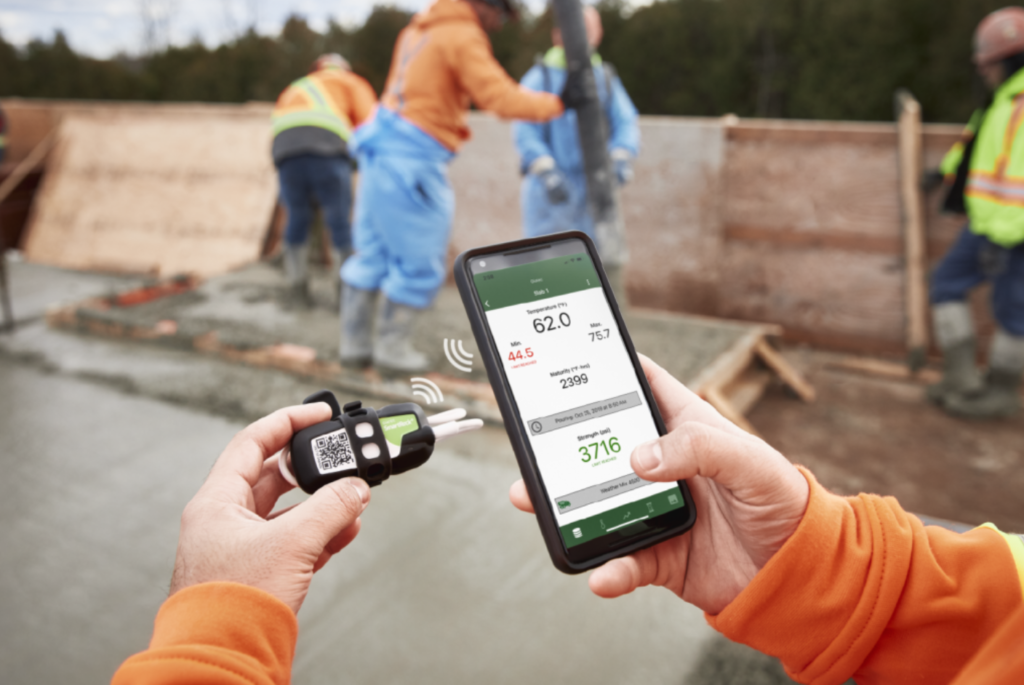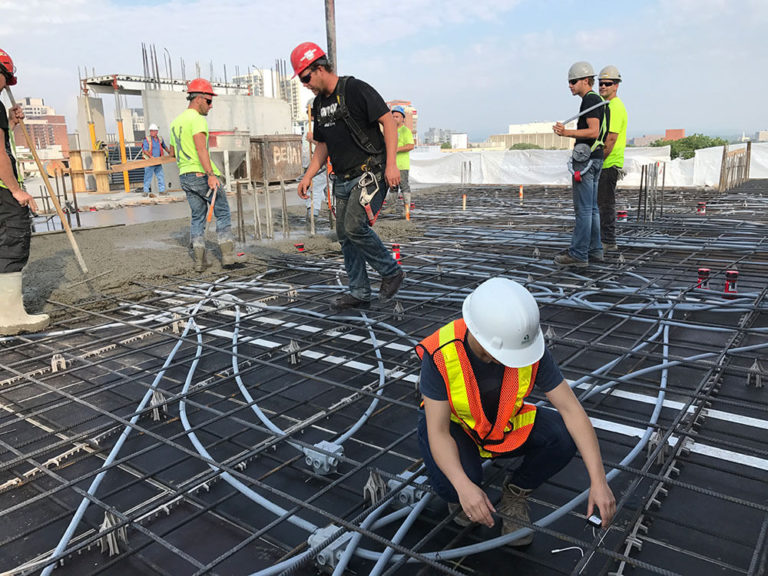Properly testing your concrete and logging data is essential to your construction project! There are many methods and tools on the market that allow you to easily gather the important temperature and strength information that you need. Concrete temperature loggers and concrete maturity devices have become increasingly popular over the last decade and there are many options available for your job site. Keep reading to find some of the best options in the market.
Explore 12 Futuristic Technology Trends Solving Concrete's Biggest Challenges.
What is Concrete Maturity?
Concrete maturity is an index value that represents the progression of concrete curing. It is based on an equation that takes into account concrete temperature, time, and strength gain. Concrete maturity is an accurate way to determine real-time strength values of curing concrete.
How Does Maturity Relate to Your Concrete Temperature Loggers?
The maturity method is a convenient approach to predict the early age strength gain of concrete, using the principle that the concrete strength is directly related to the hydration temperature history of cementitious paste. The maturity concept for estimating the strength gain of concrete is described in ASTM C1074, Standard Practice for Estimating Concrete Strength by the Maturity Method.
Thermocouples or sensors allow you to implement this method by measuring the temperature of your concrete, and then calculating its strength or maturity via a logger or app.
Learn more about the concrete maturity method here!
Different Types of Concrete Temperature Loggers
There are several different options available on the market when it comes to concrete maturity devices and concrete temperature loggers. Contractors may consider important variables such as cost, accuracy, ease of use, and how all these considerations fit into their project and budget needs.
The main types of maturity devices include wired thermocouples with an external logger, and fully-embedded wireless sensors.
1. Wired Thermocouples With an External Logger

For many decades wired thermocouples with external loggers have been used to monitor concrete temperature and gather data. The end of the thermocouple is placed within the formwork prior to the concrete pour and wired outside the formwork. These systems are usually attached to an external data logger which assists in recording temperature at certain time intervals. In this case, the process of collecting data includes collecting the information on a data medium, uploading it to a computer, exporting it in a CSV or Excel sheet, and manually analyzing the logs. However, recent developments have made it possible to attach a Bluetooth transmitter to send data as well.
Pros
- Simple and relatively inexpensive
Cons
- Labor intensive data collection and analysis process
- Data logger needs to be protected or kept in a secure place for later access
- Device’s wires are inconvenient to have on a construction site (can be easily damaged, during, or after the pour, especially during the placement and finishing stages)
Examples of Wired Thermocouples with External Loggers
Command Center by Transtec Group Inc.
These wired loggers are embedded in concrete. The wired lead can be connected to a hand-held device, such as a phone or tablet, to download to the data. You can also attach the logger to a Bluetooth transmitter to send the data to a mobile device wirelessly on the jobsite.
Con-Cure by Nex
The Con-Cure’s wired concrete temperature loggers are also embedded in concrete. The wire lead can be connected to a hand-held device to download the recorded data, or to a wireless node that will transmit the data to the cloud through cell network. You can also save the data on an SD card.
IntelliRock by Flir
The intelliRock wired maturity logger is also placed within the concrete. The wire lead can be connected to a hand-held device or can be connected to a wireless transmitter that will send the data to the cloud.
2. Fully-Embedded Wireless Concrete Sensors

Throughout the years there have been major advances in concrete-testing technology that make the process of testing much easier than common concrete temperature loggers. Fully embedded wireless sensors can be installed in the forms prior to the pour and temperature wires can be extended to the appropriate locations within the concrete form. Once the concrete is poured, the sensors and wires are completely covered, and no system components are exposed out of the concrete. Data is collected using wireless communication through a free mobile app. This application performs automatic maturity and strength calculations (as long as a calibration curve is provided) and the information can be conveniently shared with the team for collaboration and data viewing.
Pros
- Real-time data collection allows project members to make timely and well-informed decisions
- Data can be accessed anywhere from a smartphone device or tablet through wireless communication
- Completely wireless with no physical connection needed to transmit data
Cons
- Loggers must be placed within a certain distance from the surface of the concrete to ensure effective connectivity
Examples of Fully-Embedded Wireless Sensors Concrete Sensors by Hilti
Concrete Sensors by Hilti
This sensor is a fully embedded sacrificial sensor that records both temperature and humidity of concrete. The data can be seen and analyzed using Concrete Sensor’s mobile application via Bluetooth.
Converge Signal
The Converge Signal sensor is a fully embedded wireless sensor that is embedded in the concrete. The data is sent wirelessly to either a mobile device or a local hub, and then to the cloud through cell network.
HardTrack by Wake Inc.
The HartTrack sensor has a temperature measurement cable that is connected to an RFID reader. The RFID can either be embedded in the concrete or placed outside to be reused. You can use the RFID reader to retrieve the recorded data or install a local hub to wirelessly download the data.
SmartRock® by Giatec
Giatec’s SmartRock sensors are fully embedded sensors that record data wirelessly. This data is sent wirelessly either to a mobile device or a SmartHub™ located on the jobsite that then transmits it to the cloud through. The data can be analyzed either using the free mobile app in real-time on the jobsite, or on the Giatec 360™ cloud dashboard powered by AI capabilities. In the Giatec 360 platform, you can create a thermal modeling scenario and predict temperature differentials.
Learn more about the Giatec 360 Cloud Dashboard here!
vOrb by Quadrel
This sensor uses Wi-Fi communication and is embedded in the concrete. The data needs to be retrieved via a local hub before it is transmitted to the cloud.
Sources
FLIR
Note: All company, product/service names, and brands used in this article are property of their respective owners. This article is intended to be used for informational purposes only.










2 Responses
Hello! I am Afrimi from the Institute of Construction in Albania, in charge of the department of standards and expertise. I want to know how they work and if it is possible to get some models, at reasonable prices, to implement in Albania.
Hello Afrim. Thank you for showing interest in our products. Someone from our sales team has contacted you to answer your questions. Hope this helps.